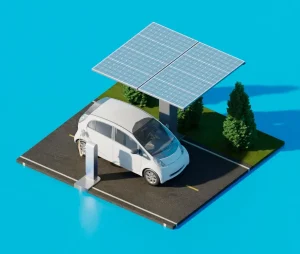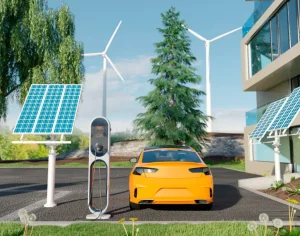電気自動車は便利で安価、そしてもちろん環境にも優しい。しかし、適切な設定をしないと充電が少し面倒になることがある。英国のデータによると、平均的な家庭用太陽光発電システムは、1日あたり3~5kWの電力を発電している。これは通常、40kWhのEVバッテリーを充電するのに十分な量だ。標準的なEV充電システムを使用する場合、約10時間かかる場合がある。
まとめると、車の充電は主に太陽光発電に頼ることができます。冬季や夜間は、バッテリーまたは系統電源に頼る必要があるかもしれません。全体として、太陽光発電は電気代を削減し、もちろん世界の二酸化炭素排出量も削減します。
太陽光発電を利用したEV充電ステーションを設置するのに、通常は大規模な太陽光発電システムは必要ありません。短距離の運転であれば、小規模なシステムでもほとんどのニーズに対応できます。太陽光発電とEV充電は理想的な組み合わせです。節約と環境に優しい運転の両方において、常に賢明な選択と言えるでしょう。

自宅に太陽光発電システムを設置してEV充電を行う方法
EV充電システムの設置はそれほど難しくないと思うかもしれません。すでにソーラーパネルが設置されている場合は、電気自動車の出力を追加するだけで済みます。ただし、正しく設置されていることを確認する必要があります。EV充電器が正しく機能するだけでなく、システム全体の耐久性にも重要です。
エネルギーニーズを理解する
最初で最も重要なステップは、自分に何が必要かを理解することです。EVをどれくらいの頻度で運転するかを考えてみてください。毎日何キロメートル、何マイル運転しますか?電気自動車の充電にはどれくらいの時間がかかりますか?
ほとんどの電気自動車充電ステーションには、出力定格が設定されていることに注意してください。EV充電には通常3つのレベルがあります。レベル1は標準的な家庭用コンセントを使用するため、比較的低速です。一方、レベル2はより高速に充電できます。ただし、このタイプの設定には特殊な配線が必要です。最後に、レベル3が最も高速です。このタイプの設定は、公共または屋外のEVステーションでよく見られます。
自宅ではレベル2を選ぶのが良いでしょう。レベル2はレベル1の充電器よりも速く電気自動車を充電できます。ただし、EVに必要な電力量を確認する必要があります。また、自宅の現在のエネルギー使用量も確認してください。これらを総合的に考慮することで、ソーラーEV充電システムの計画を立てるのに役立ちます。
適切なEV充電器を選ぶ
次に、適切なEV充電器を選ぶ必要があります。EV充電器には様々な種類があり、様々なEVモデルに対応しています。スマート充電器の中には、高度なWi-Fi接続システムを備えたものもあれば、従来通りのシンプルなプラグイン式のものもあります。あなたのEVとご自宅に最適な充電器をお選びください。
EV充電器を選ぶ際は、ご自身のEVが対応していることを確認してください。さらに、安全でレビューの良い充電器を選びましょう。人気のオンラインプラットフォームでレビューを確認することもできます。最後に、持ち運び式にするか、壁掛け式にするかを決めましょう。
レベル2のEV充電ステーションは、家庭用として最も人気があります。通常、時速約25~40kmの充電が可能です。ほとんどのレベル2充電器は240ボルトの電源を必要とします。一部のEV充電ステーションは、太陽光発電用に特別に設計されています。
ソーラー充電システムを設計する
いよいよ最も重要なステップです。太陽光発電システムの規模は、一般的に必要な電力量によって決まります。すでにご自宅にソーラーパネルが設置されている場合は、EV充電プロジェクトのためにパネルを追加する必要があります。
- ソーラーパネルをさらに追加する必要があるかもしれません。
- インバーターが既に十分な性能を備えている場合は、交換する必要はありません。ただし、すでに上限に達している場合は、インバーターを交換する必要があります。
- 予備バッテリーの追加も検討する必要があるかもしれません。EVは夜間に充電することが多いでしょう。そのような場合、バッテリーストレージは非常に重要です。
- 最後に、ソーラー EV 充電器を正しい場所に設置する必要があります。
必要なパネルの枚数を検討する必要があるかもしれません。さらに、設置全体にどれくらいの屋根スペースが必要か、そして総費用はいくらかを検討しましょう。小型EVであれば、毎日フル充電するのに2~4枚のソーラーパネルで済む場合もあることに注意することが重要です。大型車や複数のEVの場合は、さらに多くのパネルが必要になる場合があります。
ソーラーEV充電器に投資する
計画が完成したら、いよいよシステムを設置します。設置の際は、資格を持った電気技師または太陽光発電システム設置業者に依頼することをお勧めします。ただし、すでに設置に慣れている場合は、ご自身で設置することも可能です。
太陽光発電システムの設置手順は一般的です。EV充電に適した場所を選びます。充電器を太陽光発電システムに接続します。システムを設置したら、すべてのコンポーネントをテストします。最後に、EVステーションが正常に動作することを確認します。EVの充電にかかる時間を追跡するために、2~3日間観察することもできます。
最後に、いくつかの測定値を確認できます。太陽光発電量はどれくらいですか?EVはどれくらいのエネルギーを使用していますか?ご自宅の電力使用量はどれくらいですか?太陽光発電システムをVPP(Ventury Power Supply:電力供給会社)または革新的な太陽光発電ネットワークに接続することで、毎月の電力使用量を確認できます。EV充電ステーションの電力使用量が多すぎる場合は、太陽光発電システム全体の調整が必要になる場合があります。
何よりも、メンテナンスが重要です。パネルは常に清潔に保ちましょう。パネルの効率を最大限に引き出すには、年に数回清掃してください。

最後の言葉
太陽光発電によるEV充電は、明るくクリーンで、コスト削減にもつながります。ピーク時に充電する場合は、太陽光を無料で利用できます。しかし、夜間や低ピーク時には、バッテリーや系統電力に頼らざるを得ない場合があります。適切なシステムを導入すれば、ノンストップの充電環境を確保できます。
グリーンEV充電への旅を今日から始めましょう ルクスパワーテック。

